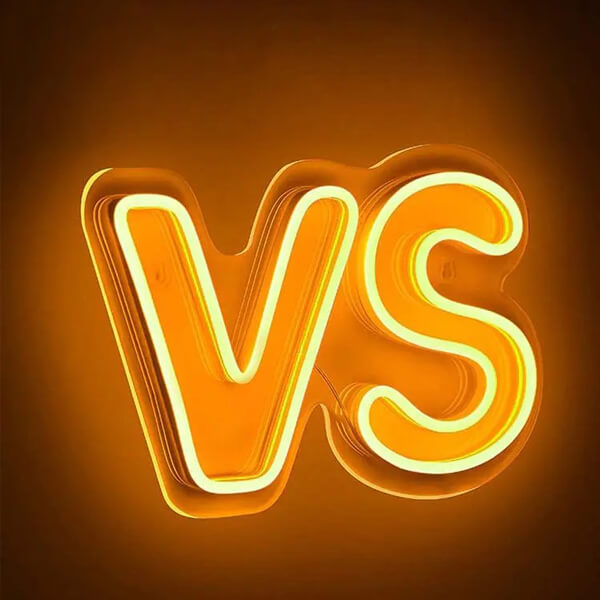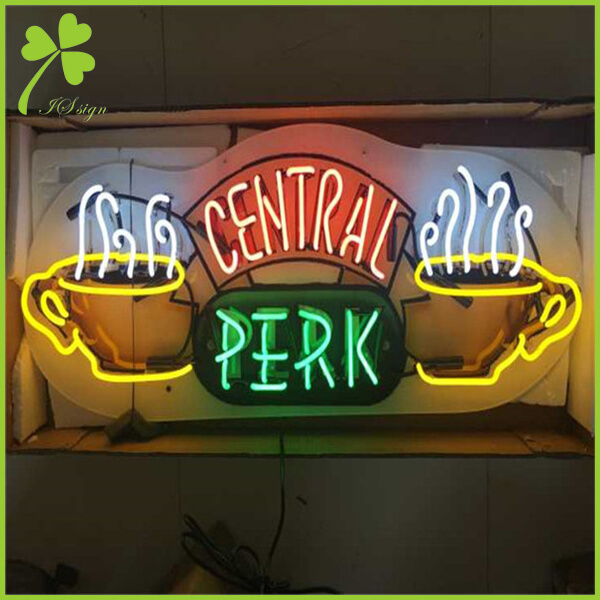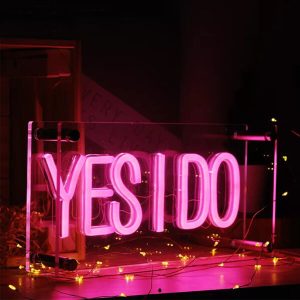LED Neon vs Glass Neon: A Comprehensive Comparison
Welcome to our esteemed blog, where we undertake a thorough and exhaustive exploration to discern the disparities between LED neon and glass neon signs.
The present escalation in the utilization of neon signs has posed a predicament for commercial entities and consumers alike, compelling them to contemplate the aptest technology to implement. LED neon signs have garnered considerable attention on account of their exceptional energy efficiency, enduring durability, and versatility in design. Conversely, the traditional glass neon signs persist in their prosperity, attributed to their magnificent hues and timeless appeal.
Our blog takes a deep dive into the benefits and drawbacks of both technologies, meticulously analyzing aspects such as production, conception, and expenditure. Whether you’re a business owner looking to invest in a neon sign or a person yearning to enhance the visual appeal of their dwelling, our comprehensive evaluation of the contrast between LED neon and glass neon will undoubtedly endow you with the wisdom to arrive at a judicious conclusion.

About the Author – Peter

As the individual responsible for authoring BgNeon, I am Peter, a seasoned professional within the LED neon sign industry boasting over a decade of experience working with BgNeon.
My heart beats fervently for the art of crafting bespoke LED neon signs that are tailored to the individual desires and requirements of every client. Possessing a comprehensive background in manufacturing, design, and customer service, I am suitably equipped to provide a thorough comparison between LED neon and glass neon signs. My vast understanding of the benefits and drawbacks of every technological option equips patrons with the ability to make well-informed judgments when deliberating between LED neon and glass neon signage. I steadfastly hold the belief that the evolution of neon signage technology is experiencing a radical transformation with the inception of LED neon. In this avant-garde domain, BgNeon has emerged as a trailblazer, offering bespoke LED neon signs that are ecologically aware, financially feasible, and durable, catered to fulfill the specific needs of every discerning client.
1. Introduction
Neon signs have been a fundamental component of the urban milieu for a considerable duration, illuminating metropolises with their dynamic hues and distinctive patterns. Nonetheless, in light of technological progress, conventional glass neon signs have encountered competition from an innovative alternative: LED neon signs.
This exposition endeavors to scrutinize the distinctions that exist between LED neon signs and glass neon signs, expounding on their respective merits and demerits, and juxtaposing their salient attributes. Conclusively, after perusing this treatise, you will possess a lucid comprehension of which sort of neon sign is optimally tailored to your requirements.
2. LED Neon Signs
2.1 What is LED Neon Signs?
 LED neon signs can be viewed as a contemporary and energy-efficient substitute for traditional glass neon signs. The design of these signs incorporates flexible silicone tubing that accommodates LED lights. These lights emit a luminosity that is uniformly distributed and intense, evocative of the iconic neon sign.
LED neon signs can be viewed as a contemporary and energy-efficient substitute for traditional glass neon signs. The design of these signs incorporates flexible silicone tubing that accommodates LED lights. These lights emit a luminosity that is uniformly distributed and intense, evocative of the iconic neon sign.
2.2 Advantages of LED Neon Signs
- Energy-Efficient: The LED neon signs exhibit a remarkable aptitude for energy preservation, exceeding their glass counterparts through their consumption of significantly reduced power, thereby rendering them a practical and ecologically-sound alternative. This phenomenon not only yields diminished expenditures in electricity bills but also a concomitant decrease in carbon footprint.
- Long Lifespan: The LED neon signs demonstrate an impressive level of durability, showcasing a prolonged lifespan of up to 50,000 hours. This measurement greatly surpasses that of their glass counterparts. Such a distinctive feature provides them with an ideal propensity for robustness and dependability, ensuring that they consistently emit light for a significant duration.
- Durability: The LED neon signs are constructed with silicone tubing and solid-state technology, making them remarkably resistant to breakage and damage. The durability exhibited by these items is without parallel, rendering them an eminently practical and enduring alternative for any enterprise.
- Ease of Installation: The installation of LED neon signs presents a remarkably facile process, owing to their notably lightweight nature and the absence of any prerequisite specialized skills or equipment.
- Safety: With regard to safety, LED neon signs operate on a lower voltage compared to glass neon signs, mitigating the possibility of electric shock and fire hazards.
- Customizability: The LED neon signs possess an unparalleled degree of personalization, affording a multifarious array of color schemes, animations, and patterns to elect from.
2.3 Disadvantages of LED Neon Signs
Color Limitations: LED neon signs exhibit certain color constraints as they may not be proficient in accurately imitating the precise tint of particular colors present in glass neon signs, notwithstanding the fact that they render a broader range of colors.
3. Glass Neon Signs
3.1 What are Glass Neon Signs?
 Glass neon signs represent the conventional manifestation of neon signage, comprising of glass tubes that are permeated with inert gas, predominantly neon or argon. Upon application of an electric current, the gas within the tubes emanates a vivid luminescence, thereby producing the quintessential neon appearance.
Glass neon signs represent the conventional manifestation of neon signage, comprising of glass tubes that are permeated with inert gas, predominantly neon or argon. Upon application of an electric current, the gas within the tubes emanates a vivid luminescence, thereby producing the quintessential neon appearance.
3.2 Advantages of Glass Neon Signs
- The visage of tradition: Behold the glass neon signs that emit an ambiance of genuineness and conviviality, which has for a significant span been tantamount to neon signs. The countenance of conventionality endures.
- Spectrum of hues: Glass neon signs present an extensive palette of colors, comprising of exceptional tints that cannot be imitated by LED neon signs.
- Inspiration for aesthetics: The art of crafting neon signs from glass demands a level of finesse and dexterity that bestows upon the final product an exquisite and creative elegance, one which has the capacity to captivate the discerning eye and evoke a deep sense of appreciation.
3.3 Disadvantages of Glass Neon Signs
- Energy Consumption: The employment of glass neon signs engenders escalated energy consumption, consequently yielding augmented electricity expenditures and a more substantial carbon footprint when contrasted with their LED neon sign counterparts.
- Shorter Lifespan: LED neon signs exhibit a markedly reduced lifespan when contrasted with their glass neon counterparts, boasting an average operational duration that spans from 10,000 to 15,000 hours.
- Fragility: The delicate nature of glass neon signs, vulnerable to damage and breakage, can be attributed to their fragility, characterized by the complexity of their glass tubing.
- Installation and Maintenance: The deployment and upkeep of neon signs composed of glass necessitate the adroitness of adept professionals, a task that may pose a daunting obstacle and substantial economic encumbrance.
- Safety Considerations: The employment of glass neon signs poses a critical issue concerning safety. This concern arises due to the substantial voltage required for their operation, which consequently leads to a significant risk of both electric shock and fire hazards. Therefore, meticulous contemplation of these potential hazards is imperative.
4. Comparing LED Neon and Glass Neon Signs
4.1 Brightness and Color Range
Both LED and glass neon signs emit luminous and animated hues. Nevertheless, glass neon signs offer a more extensive range of colors, some of which are unparalleled and exceptional, that LED neon signs may not be capable of replicating. In contrast, LED neon signs provide a more uniform and balanced luminosity, exhibiting even and uniformly dispersed brightness that remains constant.
4.2 Energy Consumption and Efficiency
LED neon signs possess the remarkable attribute of being considerably more energy-efficient than their glass counterparts, hence consuming up to 70% less energy. The ultimate consequence of this occurrence is a reduction in the expenses related to the utilization of electrical power, concomitant with a corresponding reduction in the environmental impact.
4.3 Durability and Lifespan
LED neon signs have achieved worldwide acknowledgment due to their unmatched sturdiness and prolonged lifespan, which stands in stark opposition to their glass neon counterparts. The application of cutting-edge solid-state technology and silicone tubing during the production process of LED neon signage immensely diminishes the probability of any kind of impairment or injury.
Moreover, it is crucial to emphasize the remarkable persistence of LED neon signs, which have attained extensive recognition for enduring over 50,000 hours. This is a notable feat, especially when juxtaposed with the lifespan of glass neon signs, which usually range between 10,000 to 15,000 hours.
4.4 Safety
LED neon signage operates at a reduced voltage in comparison to glass neon signage, thereby mitigating the potential of electrical shock and fire hazards. Furthermore, the implementation of silicone tubing within LED neon signage lessens the likelihood of breakage, thereby enhancing its overall safety profile.
5. Conclusion
In the ultimate examination, both LED neon signs and glass neon signs exhibit unique strengths and weaknesses. LED neon signs boast energy efficiency, durability, and safety, coupled with a prolonged lifespan and effortless installation. Conversely, glass neon signs offer a timeless aesthetic, a vast array of hues, and an artistic charm.
In conclusion, the final decision with regard to selecting between LED neon signs and glass neon signs is dependent upon an individual’s specific requirements and subjective inclinations. Choosing LED neon signs, owing to their energy efficiency, robustness, and safety attributes, would be the most prudent choice for individuals who give importance to these characteristics. On the contrary, in the event that an individual’s inclination is toward the genuine radiance and proficient artistry commonly linked to conventional glass neon signs, then the latter alternative would prove to be more fitting.
At BgNeon, our foremost goal is to prioritize the advancement of unique and individualized LED neon signs that showcase incomparable degrees of excellence and adaptability in their diverse applications. Our prospective customers are granted the chance to peruse a vast assortment of designs or engage in a collaborative discourse with our exceptionally adept team to fabricate a customized LED neon sign that is meticulously tailored to their specific requirements.





Leave A Comment